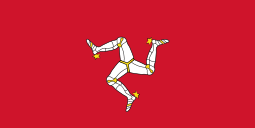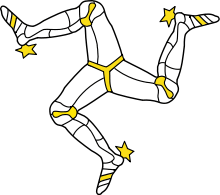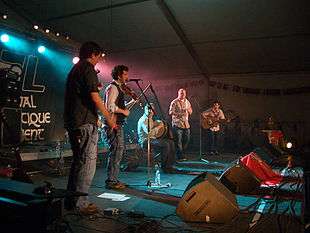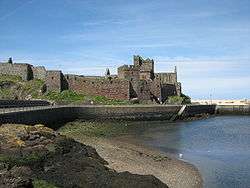Culture of the Isle of Man
The culture of the Isle of Man is influenced by its Celtic and, to a lesser extent, its Norse origins, though its close proximity to the United Kingdom, popularity as a UK tourist destination, and recent mass immigration by British migrant workers has meant that British influence has been dominant since the Revestment period. Recent revival campaigns have attempted to preserve the surviving vestiges of Manx culture after a long period of Anglicisation, and significant interest in the Manx language, history and musical tradition has been the result.
| Part of a series on the |
| Culture of the Isle of Man |
|---|
 |
| History |
| People |
| Languages |
|
Mythology and folklore |
| Cuisine |
| Festivals |
| Religion |
| Literature |
|
Music and performing arts |
|
Media |
| Sport |
|
Symbols |
Language

The official language of the Isle of Man is English. Manx Gaelic has traditionally been spoken but is now considered "critically endangered".[1]
The Manx Gaelic language is a Goidelic Celtic language and is one of a number of insular Celtic languages spoken in the British Isles. Manx Gaelic has been officially recognised as a legitimate autochthonous regional language under the European Charter for Regional or Minority Languages, ratified by the United Kingdom on 27 March 2001 on behalf of the Isle of Man government.
The Manx language is closely related to the Irish language and to Scottish Gaelic. By the middle of the 20th century only a few elderly native speakers remained: the last of them, Ned Maddrell, died on 27 December 1974. By then a scholarly revival had begun to spread to the populace, and many had learned Manx as a second language. The first native speakers of Manx (bilingual with English) in many years have now appeared: children brought up by Manx-speaking parents. Primary immersion education in Manx is provided by the Manx government: since 2003, the former St John's School building has been used by the Bunscoill Ghaelgagh (a Manx language-medium primary school). Degrees in Manx are available from the Isle of Man College and the Centre for Manx Studies. Manx-language playgroups also exist and Manx language classes are available in island schools. In the 2001 census, 1,689 out of 76,315, or 2.2% of the population, claimed to have knowledge of Manx, although the degree of knowledge in these cases presumably varied.
In common use are the greetings moghrey mie and fastyr mie which mean good morning and good afternoon respectively. The Manx language uses "afternoon" in place of "evening". Another frequently heard Manx expression is traa dy liooar meaning time enough, which is supposed to represent a stereotypical "mañana" view of the Manx attitude to life.
Manx English, or Anglo-Manx, is the historical local dialect of English, but its use has decreased. It has many borrowings from the Manx language. Early strata of Anglo-Manx contain much of Gaelic and Norse origin, but more recent Anglo-Manx displays heavy influence from Liverpool and Lancashire in North West England. The best known recorder of the Anglo-Manx dialect was the poet, T.E. Brown.
In recent years, the Anglo-Manx dialect has almost disappeared in the face of increasing immigration and cultural influence from the United Kingdom. A few words remain in general use, but apart from the Manx accent, little remains of this dialect and it is seldom heard on the island in its original form today.
Literature
The earliest datable text in Manx, a poetic history of the Isle of Man from the introduction of Christianity, dates to the 16th century at the latest.
Christianity has been an overwhelming influence on Manx literature. Religious literature was common, but surviving secular writing much rarer. The Book of Common Prayer and Bible were translated into Manx in the 17th and 18th centuries. The first Manx Bible was printed between 1771 and 1775 and is the source and standard for modern Manx orthography. The first printed work in Manx, Coyrle Sodjeh, dates from 1707: a translation of a Prayer Book catechism in English by Bishop Thomas Wilson.
With the revival of Manx, new literature has appeared, including Contoyryssyn Ealish ayns Cheer ny Yindyssyn, a Manx translation of Alice in Wonderland by Brian Stowell, published in 1990.
Symbols

For centuries, the island's symbol has been its ancient triskelion, a device similar to Sicily's trinacria: three bent legs, each with a spur, joined at the thigh. The Manx triskelion does not appear to have an official design: government publications, currency, flags, the tourist authority and others all use different variants. Most, but not all, preserve rotational symmetry, some running clockwise, others anti-clockwise. Some have the uppermost thigh at 12:00 on the clock face, others at 11:30 or 10:00, etc. Some have the knee bent at 90°, some at 60°, some at closer to 120°. Also, the degree of ornamentation of the leg wear and spur varies considerably.

The three legs are reflected in the island's Latin motto (adopted late in the symbol's history): "Quocunque Jeceris Stabit"; traditionally translated into English as "Whithersoever you throw it, it will stand", or "Whichever way you throw it, it will stand".
The origin of the Three Legs of Man (as they are usually called) is explained in the Manx legend that Manannan repelled an invasion by transforming into the three legs and rolling down the hill and defeating the invaders.
Religion
The predominant religious tradition of the island, Anglican Christianity, was not the original religion, but was introduced to the Manx people by the English. The ancient Christian Church of the island is today part of the Church of England. The present-day Anglican Diocese of Sodor and Man traces its history - through many changes in tradition and detail - to 1154. Like all ancient Anglican churches, the diocese formed part of the then mainstream of western Christian tradition, the Roman Catholic Church until the 16th-century English Reformation. The diocese has been part of the national churches of Norway, Scotland, and England.[2] It has also come under the influence of Irish religious tradition. Since 1541[3] its bishop and 28 parishes[4] have formed part of the ecclesiastical Province of York.[5]
Other Christian churches also operate on Mann. The second-largest denomination is the Methodist Church, which is close in size to the Anglican diocese. There are eight Roman Catholic parish churches, under the authority of the Roman Catholic Archbishop of Liverpool. Additionally there are five Baptist churches, four Pentecostal churches, the Salvation Army, the Church of Jesus Christ of Latter-Day-Saints, a congregation of Jehovah's Witnesses, two United Reformed churches, and other Christian churches. There are also many other faith organisations on the island.[6] The small Muslim community has a mosque in Douglas, which local worshippers regularly attend several times a day.[7] There is a small Jewish community on the island, with a synagogue in Douglas.[8]
Music

Prior to the 15th century, little can be determined about the character of music on the Isle of Man. There are many carved crosses from this era, but they depict a total of two musicians, one lur player and a harpist. Songs from this era may have had Scandinavian origins; some also bear similarities to Irish and Scottish music. The song Reeaghyn dy Vannin (the Manx sword dance), is very similar to a lullaby from the Hebrides and is also said to have been a ritual dance during the Scandinavian era.
Church music is the most documented Manx music of the 19th century. The first collection of Manx church songs was printed in 1799, and was followed by many other collections, though it was not until the 1870s and 1880s that Manx music began to be published in any great quantity, as drawing-room ballads, religious songs, and choral arrangements all became popular. The proliferation of this music coincided with a boom in the tourism industry for the Isle, and Manx music-hall and dance-hall songs and dances saw increased demand.[9]
By the 20th century instrumental music accompanied most worship on the Isle of Man. Later in the 20th century, Manx church musical traditions slowly declined.
The 1970s folk revival was kickstarted, after the 1974 death of the last native speaker of Manx, by a music festival called Yn Çhruinnaght in Ramsey.[10]
Culture Vannin has a dedicated Manx Music Development Officer who works to promote Manx music and dance in both the school curriculum and the wider community. CDs by bands, soloists and Gaelic choirs are frequently produced.
Myth, legend and folklore
The name of Isle of Man is eponymous after Manannán mac Lir, a Celtic sea god, according to an old Irish lexicon (Cormac's glossary or Sanas Cormaic).[11] A further tidbit of Manx mythology provides that Manannan, who was "the first man of Man, rolled on three legs like a wheel through the mist" (O'Donovan, the translator of the glossary.[12] Manannan was called "The Three-Legged Man" (Manx: Yn Doinney Troor Cassgh) and all the inhabitants were three-legged when St. Patrick arrived.[13]
A "traditionary ballad" entitled Mannanan beg mac y Leirr; ny, slane coontey jeh Ellan Vannin ("Little Mannanan son of Leirr; or, an (whole) account of the Isle of Man")(dated to 1507-22), states that the Isle of Man was once under the rule of Mannan, who used to impose a token tax from the island folk, until St. Patrick came and banished the heathen. One quatrain runs: "It was not with his sword he kept it/ Neither with arrows or bow. / But when he would see ships sailing, / He would cover it round with a fog." (Str. 4) ". So Mannanan here is said to have raised a mist or fog to conceal the whole island from detection (cf. Féth fíada). The fee or rent that Mannanan demanded was a bundle of coarse marsh-grass like rushes (leaogher-ghlass),[14] to be delivered every "Midsummer Eve" (June 24th) [15]
In the Manx tradition of folklore, there are many stories of mythical creatures and characters. These include the Buggane, a malevolent spirit who according to legend blew the roof off St Trinian's Church in a fit of rage; the often helpful but unpredictable Fenodyree; the Glashtyn who may be a hairy goblin or water-horse who emerges from his aquatic environs; and the Moddey Dhoo, a ghostly black dog who once wandered the walls and corridors of Peel Castle and frightened the guards on duty.
Mann is also said to be home to the mooinjer veggey /muɲdʒer veɣə/) or the little folk in the Manx language, though they are sometimes referred to obliquely by locals as themselves. There is a famous Fairy Bridge and it is said to be bad luck if one fails to wish the fairies good morning or afternoon when passing over it. Other types of fairies are the Mi'raj (???) and the Arkan Sonney or Arc-Vuc-Soney "Lucky-Boar-Pig".[16]
An Irish folktale attributes the formation of the Isle of Man to Ireland's legendary hero Fionn mac Cumhaill (commonly anglicised to Finn McCool). Finn was in pursuit of a Scottish giant, and hoping to prevent his escape by swimming across the sea, scooped a huge mass of clay and rock from the land mass and hurled it; but he overshot, and the chunk of earth landed in the Irish Sea, thus creating the island. The hole he gauged out became the Lough Neagh.[17]
Cuisine

Traditionally the national dish of the island is Spuds and Herrin, boiled potatoes and herring. This plain dish is chosen because of its role supporting the subsistence farmers of the island, who crofted the land and fished the sea for centuries.
A more recent claim for the title of national dish would be the ubiquitous chips, cheese and gravy. This dish, which is similar to poutine, is found in most of the island's fast-food outlets, and consists of thick cut chips, covered in shredded Manx Cheddar cheese and topped with a thick gravy.[18] Baked potato with a variety of toppings such as chili beans is a popular fast-food dish not typically served in English take-aways.
Seafood has traditionally accounted for a large proportion of the local diet. Although commercial fishing has declined in recent years, local delicacies include Manx kippers (smoked herring) which are produced by the smokeries in Peel on the west coast of the island, albeit mainly from North Sea herring these days. The smokeries also produce other specialities including smoked salmon and bacon.
Crab, lobster and scallops are commercially fished, and the Queen scallop (Queenies) is regarded as a particular delicacy, with a light, sweet flavour. Cod, ling and mackerel are often angled for the table, and freshwater trout and salmon can be taken from the local rivers and lakes, supported by the Government fish hatchery at Cornaa.
Cattle, sheep, pigs and poultry are all commercially farmed, Manx lamb from the hill-farms being a popular dish. The Loaghtan, the indigenous breed of Manx sheep, has a rich, dark meat that has found favour with chefs, featuring in dishes on the BBC's MasterChef series.
Manx cheese has been a particular success, featuring smoked and herb-flavoured varieties, and is stocked by many of the UK's supermarket chains. Manx cheese took bronze medals in the 2005 British Cheese Awards, and sold 578 tonnes over the year. There are not many unique desserts, although the Peel flapjack is a popular one.
Beer is brewed on a commercial scale by Okells Brewery (established in 1850), Bushy's Brewery and Hooded Ram Brewing Company (established in 2013). The island has a beer purity law, resembling the German Reinheitsgebot, dating from 1874.[19]
Sports
The Isle of Man is represented as a nation in the Commonwealth Games and the Island Games and hosted the IV Commonwealth Youth Games in 2011. Manx sports people have won three golds at the Commonwealth Games, the most recent being Mark Cavendish, a professional cyclist, in 2006 in the Scratch race. Cavendish has had great success in cycling, having won twenty five stages of the Tour de France to date and the Milan–San Remo classic. The island started the Island Games in 1985, and also hosted the Island Games in 2001.
Isle of Man teams and individuals participate in many sports both on and off the island including rugby union, football, gymnastics, hockey, netball, bowling and cricket. It being an island, many types of watersports are also popular with residents.
Motorcycle racing
The main international event associated with the island is the Isle of Man Tourist Trophy race, colloquially known as "The TT",[20] which began in 1907. It takes place in late May and early June. The TT is now an international road racing event for motorcycles, which used to be part of the World Championship, and is long considered to be one of the "greatest motorcycle sporting event of the world”.[21] Taking place over a two-week period, it has become a festival for motorcycling culture, makes a huge contribution to the island's economy and has become part of Manx identity.[22] For many, the Isle carries the title "road racing capital of the world".[23]
The Manx Grand Prix is a separate motorcycle event for amateurs and private entrants that uses the same 60.70 km (37.72 mi)[24] Snaefell Mountain Course in late August and early September.
Cammag
Cammag is the national sport of Mann. It is similar to the Irish hurling, and Scottish game of shinty. Once the most popular sport on the island, it ceased to be played by the start of the 20th century. It has more recently been revived with an annual match at St John's.
See also
- Mananan festival
- Registered Buildings of the Isle of Man, which include a number of architectural works and other cultural sites
References
- "UNESCO accepts Manx language is not 'extinct'". Isle of Man Government. 19 August 2009. Archived from the original on 11 May 2011. Retrieved 20 August 2009.
- Moore, A. "Diocesan Histories. Sodor and Mann". Isle-of-man.com. Retrieved 1 October 2017.
- Act of Parliament (1541) 33 Hen.8 c.31
- Gumbley, Ken. "Diocese of Sodor and Man". Gumbley.net. Retrieved 1 October 2017.
- Office, Anglican Communion. "Page not found - Anglican Communion". Anglican Communion Website. Archived from the original on 28 May 2012. Retrieved 1 October 2017.
- Isle of Man Government: Religious Faiths and Organisations
- Muslims in Britain (30 November 2009). "Isle of Man Islamic Association". Mosques.muslimsinbritain.org. Retrieved 21 May 2010.
- David M.R. Shulman (2 August 2009). "The Jewish Community on the Isle of Man". Jewishgen.org. Retrieved 16 March 2010.
- Guard 1980, pp. Preface
- "Trad music in the Isle of Man". Ceolas.org. Retrieved 1 October 2017.
- Stokes & O'Donovan 1868, Sanas Cormaic, p.113, under the heading of "Manannan mac Lir": "Et de nomine Manannan the Isle of Man dictus est."
- Stokes & O'Donovan 1868, p.113, O'Donovan's note: "According to the traditions in the Isle of Man.. ..". O'Donovan says the lore existed in the eastern parts of Leinster as well, though Whitley Stokes, the editor of the same book, said he has never heard anything like it.
- Moore 1895, Further Notes", p.42.
- Cregeen 1835Dict., p.104: leagh'yr or laghyr, s. f. coarse grass like rushes (mire grass)
- Moore 1891 Folklore of the Isle of Man, Chapter 6 Customs and Superstitions Connected with the Seasons
- Moore 1895, "Further Notes on Manx Folklore", p.268
- Kennedy, Fictions of the Irish Celt, p.280; cited and synopsized by Moore 1895, "Further Notes on Manx Folklore", p.42
- Isle of Man - Factfile - Daily Life Archived 29 January 2010 at the Wayback Machine
- Purely Isle of Man Archived 3 August 2010 at the Wayback Machine
- Wright, David. 100 Years of the Isle of Man TT: A Century of Motorcycle Racing. The Crowood Press, 2007
- Disko, Sasha. The Image of the “Tourist Trophy” and British Motorcycling in the Weimar Republic. International Journal of Motorcycle Studies, Nov 2007
- Vaukins, Simon. The Isle of Man TT Races: Politics, Economics and National Identity. International Journal of Motorcycle Studies, Nov 2007
- Faragher, Martin. “Cultural History: Motor-Cycle Road Racing.” A New History of the Isle of Man Volume V: The Modern Period 1830-1999. Ed. John Belchem. Liverpool: Liverpool University Press, 2000
- "Archived copy" (PDF). Archived from the original (PDF) on 10 March 2012. Retrieved 2012-03-10.CS1 maint: archived copy as title (link) page 4
